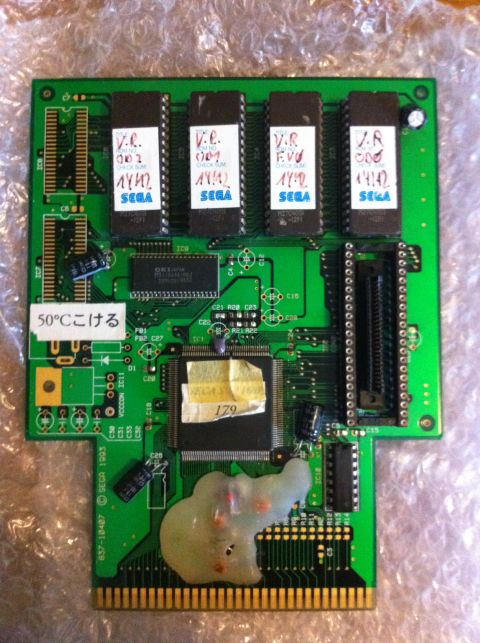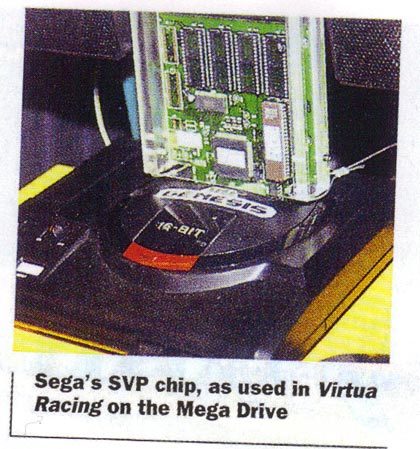

This cartridge seems similar, but not quite the same, as the one which appears in this old magazine photo.

As you can see, the cartridge itself is quite interesting. Here are some main points of interest:
-There's a chip connector on the righthand side of the board, which is currently empty. I believe this cartridge is designed to take either the 4 separate EEPROM's, which this board currently has, or a single EEPROM, like the one used on the final Virtua Racing board. This is supported by the magazine photo shown above, which has the single chip instead of the 4 separate chips. Interestingly, there's also another connector under this chip connector. I believe this connector was probably used to simulate the ROM chip, and stream directly from a development machine, allowing them to test code without having to burn to EEPROM.
-One of the pins on the SVP has a small wire soldered to it, which is looped back over the top of the chip and is and resting under some tape. Maybe this pin is a test pin of some sort?
-There's a small paper label on top of the SVP with the words "SEGA SVP 160P" written on the top line, and the number "179" written below. Underneath the paper label, on the SVP chip itself, is the writing "SEGA160FS", with the writing "ES311" on the line below.
-On the back of the board right above the cartridge connector, something has been written by hand with a marker. It appears to start with the letters "DSP", then some text I can't quite decypher. It might be "600ASOG"? I believe this writing is giving the model number of the internal DSP core, which would be significant. I have a theory that a leading "1" has been rubbed off, and that the string is supposed to start with DSP1600. the SSP1600 is the same as the SSP1601, except that it has a 24-bit ALU instead of a 32-bit ALU, and can only operate up to 20MHz instead of 25MHz. I haven't checked to see, based on the notes by Tasco Deluxe, if it appears this could in fact be an SSP1600-based core.
You can get a datasheet for the SSP1600 here:
http://pdf.chinaicmart.com/2008712/2008 ... 386382.pdf
The datasheet says the architecture of the SSP1600 is based on the Clarkspur CD2400, but I haven't had a lot of success finding solid documentation for that chip either unfortunately. I think it's Clarkspur documentation that gave Tasco Deluxe a starting point for his work on the SVP though IIRC.
I've got some more detail shots under the following links. These photos are stored in full resolution as they were taken, with close-ups of some points of interest:
http://nemesis.hacking-cult.org/MegaDri ... G_0560.jpg
http://nemesis.hacking-cult.org/MegaDri ... G_0561.jpg
http://nemesis.hacking-cult.org/MegaDri ... G_0562.jpg
http://nemesis.hacking-cult.org/MegaDri ... G_0566.jpg
http://nemesis.hacking-cult.org/MegaDri ... G_0567.jpg
http://nemesis.hacking-cult.org/MegaDri ... G_0568.jpg
http://nemesis.hacking-cult.org/MegaDri ... G_0570.jpg
http://nemesis.hacking-cult.org/MegaDri ... G_0572.jpg
http://nemesis.hacking-cult.org/MegaDri ... G_0573.jpg
http://nemesis.hacking-cult.org/MegaDri ... G_0574.jpg
http://nemesis.hacking-cult.org/MegaDri ... G_0575.jpg
http://nemesis.hacking-cult.org/MegaDri ... G_0576.jpg